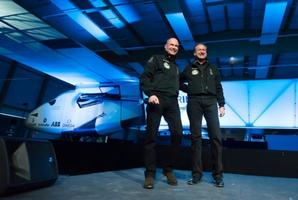PLASTICS NEWS REPORT
Published: April 10, 2014 1:45 pm ET
Updated: April 10, 2014 1:52 pm ET

Image By: Solar Impulse
André Borschberg and Bertrand Piccard unveiled their solar-powered plane, the Solar Impulse, on April 9. The plane uses plastics in multiple parts.
Bayer MaterialScience AG and Solvay Group are supplying plastic materials for the new Solar Impulse ultralight plane in preparation for the first fuel-free around-the-world flight.
The Solar Impulse 2 aircraft was unveiled in Payerne, Switzerland, on April 9. The plane is set to undertake the journey in March 2015.
The predecessor Solar Impulse 1 successfully completed its day and night tour across America last summer.
With a 72 meter wingspan, the plane’s weight of 2.34 tons is similar to that of a Jeep, while its horsepower is similar to a motorbike’s.
Solvay Group announced that the plane has about 6,000 parts that contain its materials, which include nylon 6 and 6/6, PEEK and PVDF.
“Thanks to Solar Impulse, Solvay’s advanced chemical solutions and advanced materials have accessed a host of promising new markets, including solar panel protection, computer and mobile phone batteries, baggage compartments on planes and sustainable solutions in mobility,” the company said.
Bayer MaterialScience, which partnered with Swiss pioneers Bertrand Piccard and André Borschberg for the project in 2010, was responsible for the design of the insulation system in the cockpit’s shell. The firm’s Baytherm Microcell boasts thermal insulation properties up to 10 percent above current standards, BMS said in a news release.
Baytherm Microcell was also used for the aircraft door, while the rest of the cockpit shell comprises a different type of rigid polyurethane foam.
BMS also supplied a polyurethane/carbon fiber composite material for the door locks and thin sheets of transparent polycarbonate for the window. Although the cockpit is larger than its prototype, it is only minimally heavier.
Outside of the cockpit, rigid polyurethane foam from Bayer MaterialScience insulates the batteries and the company supplied the raw materials for the aircraft’s silvery coating and the adhesives that hold the textile fabric underneath the wings. | 